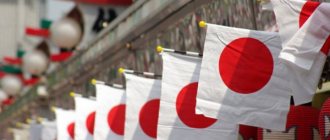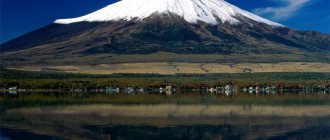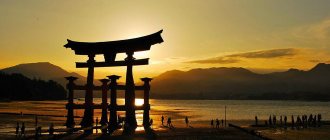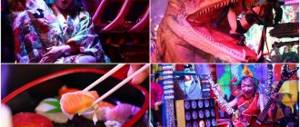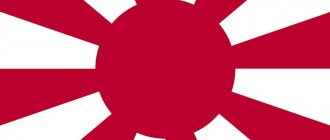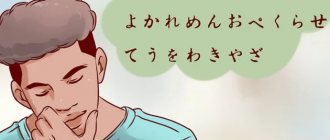Japan is a country of amazing traditions. In Japanese culture, medieval morals are paradoxically combined with a passion for the total use of high technology in all spheres of life. The customs of modern Japanese are built around ancient secular traditions, as well as around two religions - Buddhism and Shintoism (an ancient pagan faith). About 80% of the country's residents claim to profess both religions, which looks strange in the eyes of representatives of other cultures. This is largely why Japanese rituals seem so unusual to foreigners.
The Japanese funeral is perhaps the most unusual of these rituals, as death in Japan is associated with a whole range of traditions and ceremonies.
The concept of death in Japan according to Buddhism and Shintoism
To briefly formulate the concept of death in Buddhism, it is a consequence of the disintegration of dharmas or a combination of properties, phenomena, substances, which are divided into 5 groups that contribute to the creation of a psychosomatic system (human). When this process is disrupted, a person ceases to exist in the physical shell. According to Buddhism, the main thing in human life is the desire for its rethinking and liberation. After the disintegration of dharmas, a new combination of them is formed. This facilitates the transition to a new life, which starts the process of reincarnation.
Shintoism is based on the belief that all things are animate. Devotees worship deities, but, in addition to them, also the souls of those who have passed away. The religion is based on manuscripts from ancient Japan. Death, according to Shintoism, is not considered bad, but it still violates the purity of the body, which interferes with participation in worship. Because of this, the dead were not buried on the territory of the temple, and traditional rituals were not performed over them.
THE RELIGIOUS TREND HAS HELPED STRENGTHEN THE BELIEF THAT THE SOULS OF THE DEAD PROTECT THE LIVING AND CAN BE TEMPORARILY ON THE EARTH.
Ancient Shinto faith
Japanese funeral traditions. Who takes charge of the organization
Traditional Japanese funerals are decorated as richly as possible. It is believed that this is the main condition for ensuring a good position for the soul after death in the next world. This feature also contributes to rising prices for funeral services and the organization of funeral processions.
ALL ACTIONS ARE PERFORMED AFTER RECEIVING THE DEATH CERTIFICATE.
The funeral home is involved in the preparations, but many points are noted that require the participation of loved ones. It is also possible to organize the funeral yourself.
Relatives need to make a unanimous decision on the issue of choosing a date. This is due to the fact that not all numbers are suitable for holding a funeral. Death is taken seriously in Japan; the use of the number 4, 7, or several words containing the corresponding combination of symbols is avoided. The closest relatives are responsible for organizing the procession:
- husband;
- wife;
- eldest son.
Funeral in Japan
Japanese funeral culture. Continuation.
In August 2021, the funeral exhibition ENDEX-2018 was held in Tokyo. Funeral Portal correspondents went to Japan to get acquainted with the peculiarities of the funeral industry and the traditions of the funeral culture of this unusual country.
We continue our story about the funeral traditions of modern Japan.
Japan's funeral culture is a mixture of ancient traditions and modern technology. Rituals and rituals are closely related to Buddhism and Shintoism, the dominant religions of this country. Imperial traditions of past centuries are also firmly rooted in burial traditions. Preparations for the funeral, farewell ceremony and commemoration are in most cases accompanied by religious rites. Although, according to funeral specialists, non-religious funerals are occupying an increasing place in funeral traditions. Funeral homes, following funeral fashion trends, offer mourners services for both religious and civil funeral services.
Funeral
After the death of a loved one, funeral preparations begin. The eldest son usually takes responsibility for organizing the funeral. Rituals of washing and vesting are carried out for the most part in funeral homes. All procedures are carried out by a funeral home specialist. The woman's body is dressed in a traditional funeral costume (kimono), consisting of certain items. Men are most often buried in a suit. A white kimono, sandals and six coins are placed in the coffin - payment for crossing the Sanzu River. Also, things that the deceased loved during life (for example, cigarettes, candies) are placed in the coffin.
The funeral of the deceased is held 2-7 days after death, as soon as all invited guests are able to arrive at the funeral. Relatives and superiors of the deceased are notified, and the municipality issues a Death Certificate.
There are no strict requirements regarding the day of the funeral. However, there are “undesirable” days for burial, which, according to superstitious beliefs, occur once a month and are called “tomobiki”; these days, all business ends in failure, and funerals entail someone else's death. The only immutable rule is that loved ones must spend the night near the body of the deceased on the day of his death.
In each funeral home, in addition to the room for prayers and farewells, there are separate 2-3 “apartments” with a bathroom, living room and kitchen for the families of the deceased, where they spend about a day in prayers and memories of the deceased.
The next day, a farewell ceremony is organized in the funeral hall in one of the funeral homes, which lasts no more than an hour. Before the general ceremony, close relatives spend 2-3 hours with the body of the deceased in a small room in the funeral home. The body is displayed in an open coffin in a sarcophagus with a refrigerator, behind glass; at the request of the relatives, the sarcophagus can be opened.
Children must participate in a family farewell at the coffin. There is a special ceremony for them. A child under 10 years old must be brought to the coffin of his grandmother or grandfather; he must touch the hand or cheek of the deceased, feel the coldness of the dead skin. After this, mom or dad hugs the child to themselves so that he feels the difference between the warm mother and the cold body of the grandmother. His parents explain to him in detail the process of dying and the difference between a living and a dead person.
After the family farewell, the coffin with the body is displayed in the funeral hall in front of the “altar”, decorated in a special way with fresh flowers. The coffin is placed with the head facing north or west (Buddhists do this to prepare the deceased for the journey to Western Paradise)
Here everyone else - friends and colleagues - can say goodbye to the deceased. The size of the funeral altar, the number of fresh flowers and the design of the decoration depend on the status of the deceased and the financial capabilities of his family.
Immediately after the farewell ceremony, all guests take part in a funeral dinner, which is usually prepared in an adjacent hall of the funeral home or in a restaurant.
Japanese funerals are among the most expensive in the world. According to statistics, the average cost of a funeral is about 2.3 million yen ($25,000). This amount, in addition to funeral supplies, rent of a hearse, and a farewell hall, also includes food for the personnel serving the funeral and the services of the priest (about 500,000 yen). The minimum cost of renting a funeral room for 2 days is 2-2.5 thousand dollars.
In Japan, donations to the family from all funeral participants are accepted. Money is brought as a sign of condolences in a special envelope decorated with silver and black flowers. Depending on the relationship with the deceased and his status, this amount can vary from 3,000 to 30,000 yen.
Visitors come to funerals dressed in black. Men wear a black suit with a white shirt and a black tie, women wear a black dress. At an official funeral, the spouse and close relatives must wear a mourning black kimono. If the family of the deceased professed Buddhism, guests usually bring with them ritual prayer beads (juzu).
A person who has attended a funeral is considered defiled. Before entering his house, he must sprinkle fine salt on his shoulders, throw some salt on the ground and step on it with his feet in order to cleanse himself above and below and not bring filth into the house. Each participant in the funeral ceremony receives a bag of salt before leaving home.
Official funeral ceremonies - for businessmen, officials, scientists - are held on a grand scale at the main municipal funeral complex in Tokyo. Huge mourning halls can accommodate hundreds of mourners and are equipped with the latest technology. The ceremony can last several hours and necessarily includes speeches by officials - from work colleagues to the President of the country. The cost of renting a complex for 2 days of such a funeral starts from 2,000,000 yen or about $20,000. Making a magnificent altar is not included in this price. Its design is ordered from a specialized florist company.
Cremation
Cremation of the body takes place the next day at the crematorium. In Tokyo, all crematoriums are separate from funeral homes and provide only cremation services with a small ceremony for close relatives.
At the crematorium, the body is placed on the tray of the cremation oven. A family watches the body being loaded into the cremation facility. The cremation lasts about two hours and the family returns at the end. The tray with ashes is pulled out of the oven, the ashes cool down. Two relatives use large sticks to move large bone remains from the ashes to the urn. The bones of the legs are placed in the urn first, and the bones of the head last, with the hyoid bone considered one of the most important.
In some cases, the ashes may be divided into several parts into different urns. The main urn remains with the family. Some of the ashes may remain in the temple, some may be scattered, made into a diamond, or sent into space. Depending on local customs, the urn may either remain at home for a few days or be immediately sent to a cemetery or columbarium.
Embalming
The majority of the deceased in Japan are not embalmed; less than 10% of the deceased are treated with chemicals in special cases where the body needs to be preserved for a long time. Bodies are preserved until the day of the funeral with the help of refrigeration units, which are used at all stages of pre-funeral preparation and mourning ceremony - from freezing mattresses to special sarcophagi in which the body is displayed for farewell. Refrigeration equipment is supplied to all funeral homes by Mitsubishi.
After death, the lips of the deceased are moistened with water, this process is called the “Water Ceremony at the Minute of Death.” A small table with flowers, incense and candles is placed next to the bed of the deceased. A knife is sometimes placed on the chest of the deceased to ward off evil spirits. The process of preparing the body includes mandatory procedures for disinfecting the body with special disinfectants. products, tamponing of natural orifices and post-mortem makeup using thanatocosmetics. Preparation of the body is carried out by a trained funeral director in the family funeral room the night before the funeral.
Cemeteries and columbariums
After cremation, the family of the deceased has the opportunity to dispose of the ashes of a loved one in one of the selected ways: purchase a place in the cemetery and a family crypt made of granite (the maximum plot area for one family crypt is 0.6 sq. m), place the urn for 15 years in a columbarium building, or scatter dust.
Public cemeteries in Japan are well-kept parks within the city, open to all visitors during the day. Ashes are not buried in the ground. Urns with ashes are placed in the same type of above-ground structures made of natural stone (gray or black granite) in a special hole or behind a metal door with a lock. A family memorial is a type of prayer altar that provides space for flowers, offerings, and the burning of ritual scented candles.
The date the monument was erected and the name of the person who bought it may be engraved on the side of the vertical slab. The names of the deceased, as well as a family symbol (usually a flower), are placed on the front of the monument. If one of the spouses dies before the other, the name of the living one may also be engraved on the tombstone in red hieroglyphs. After his death and burial, the red ink is washed off. This is done for financial reasons, since it is cheaper to apply two names at once than to order the second name separately.
A special feature of the Japanese family crypt is the wooden sotoba boards, which are placed in special grooves behind the monument. The name of the deceased, the date of death, and sometimes the text of a short prayer are written on the tablet. The first tablet is made immediately after death, then on each anniversary of death. Thus, by the number of tablets one can determine how long ago the burial was made. The planks are not secured in any way, so in a strong wind they sway from side to side, and there is a specific wooden knock throughout the cemetery.
Some graves have a special compartment where everyone can drop off their business card or condolence card. In this way, relatives can find out about those who visited the grave and expressed their condolences.
On many tombstones in Japanese cemeteries you can find small stone figurines called Jizo. The Jizo figurine has long represented the protector of the spirits of those who died in the womb, miscarriages and deceased children; they are always present in public cemeteries and tombs at Buddhist temples, as well as along city streets to protect travelers. In modern Japanese culture, Jizo is a sign of memory of deceased children, as well as a “guardian angel” for children and grandchildren. Therefore, when parents come to a temple or cemetery, they must put a white apron-bib and a red knitted cap on the Jizo figurine in order to warm Jizo and ask for protection for their children. A children's wind spinner is often also placed next to the figurine. Before entering the temple, parents also tie a wooden sign wishing health to their children or an epitaph to the untimely departed.
Burying the ashes in the family crypt at the cemetery will cost the family several million yen. The average cost of a family crypt made of granite is about 1.5-2 million yen. Storing ashes in a columbarium building will cost much less - from 800,000 yen for 15 years. If the urn is left in such a columbarium longer, the family pays several thousand yen a year to maintain the columbarium.
Vertical "cemeteries"
The lack of available land for cemeteries and, as a consequence, the exorbitant cost of burial in a cemetery, has led in Japan to the creation of multi-level columbariums that can store tens of thousands of urns.
There are several such vertical cemeteries in Tokyo, one of them is Ruri-koin - a 5-story building in the center of the capital, located in an office district with dense buildings.
Architects in Tokyo are developing several more projects for multi-story columbariums, which are planned to be built in the city in the coming years.
The Ruri-koin Columbarium is a five-story concrete building with unusual architecture. Inside, the building is equipped with elevators, a ventilation and air conditioning system, and decorated with modern materials. On 3 floors along the perimeter of the building there are several “memorial rooms” with a Buddhist or Shinto altar and attributes, as well as rooms without religious symbols.
The interior of the building between the halls and underground is a robotic shelving system for storing urns, reminiscent of a library of urns. The storage facility is equipped with manipulators and a Toyota computer system. The technology is kept strictly secret and hidden from prying eyes behind thick walls.
After concluding a contract for storing the urn in the columbarium, the family is given a plastic card with the recorded data of the deceased and the storage location. The varying costs of services determine the type of room a family can use for remembrance and prayer at any time. Thus, a room on the south side of the building, where through the huge windows you can admire the cherry blossoms in the spring, costs more than the same room on the north side.
Coming to the columbarium, a relative of the deceased places his card on the terminal on the ground floor and receives information on the screen which room he can use. While the visitor takes the elevator to the desired floor and comes to the room, the robot finds the desired container with an urn and delivers it to the specified room. The container with ashes is inserted along internal rails into the hole in the stone altar in the center of the room. A photo of the deceased, an epitaph, text or slides with home photos appear on a small screen nearby. The glass doors slide open, and a relative or entire family can spend time next to the ashes of a loved one, perform the Buddhist ritual of burning incense, or simply listen to soft music. As soon as the family leaves the room, the container with the urn is sent back to its rack in storage.
On the upper floors of the building there are churches and prayer rooms for all faiths, where relatives can pray or request a memorial service from a priest.
Other funeral homes have similar urn storage systems, but the multi-story storage facility is the only one in Tokyo so far.
Ancestor cult
It is believed that after death the deceased does not leave his family, continues to be a member of it, but being in a new state at the highest level of the family-tribal hierarchy.
Memorial services for the deceased depend on customs in a particular area: after a funeral, memorial services are held within the first 7 or 49 days after death, or on the 7th, 49th and 100th days. During the year, memorial services are usually held four times: on the New Year, on the Obon holiday, on the days of the spring and autumn equinox. During the several days of Obon celebration, a special treat is placed on the altar of the ancestors - boiled rice, green tea, miso soup - traditional Japanese food. These days, stores sell already prepared and decorated funeral dishes.
Since the deceased continues to be a member of the family, they communicate with him as if he were alive. For example, a schoolchild, having received a certificate, shows it to his late grandparents, presenting it on his knees in front of the altar with a brief story about the circumstances of receipt. The ancestors are also told about important purchases and may leave new property at the altar for several days.
The names of the deceased are written on wooden tablets and placed on the home altar. The altar should only be in the “main” house - the house of the eldest son. In the house of the youngest son—the “separated house”—there is not supposed to be an altar until someone dies in the house.
An ancestor does not remain in the family forever in the form of a death plaque. It is believed that after the change of two generations, the memory of the deceased is lost. The head of the house can burn the tablet, throw it into the sea, or give it to a Buddhist temple.
We offer you a short photo tour of cemeteries, crematoria and funeral homes in Tokyo
Events and rituals immediately after the death of a relative
The Japanese have many rules for conducting funerals, each with sacred meaning. Violating the established order can cause harm to the soul of the deceased or living people.
The most ancient ritual in the family circle is “a posthumous sip of water”
Before a deceased person is cremated or buried in a cemetery in Japan, several ceremonies are performed. The first action after death is to invite a priest, an employee of the funeral agency. While they are waiting, a ritual called “the last sip of water” is performed. In this case, you need to moisten the lips of the deceased with damp cotton wool wrapped around a chopstick. The custom is also called the “Water Ceremony.”
Preparation for the ceremony
Washing and preparing the body at a funeral in Japan
Like many countries, Japan has a tradition of body washing. The main procedure is based on its cleansing. It is necessary to wash the body with hot water. Additionally, you need to wipe the skin over the entire surface with a disinfectant. Alcohol will do.
EMBALMING IS MOST OFTEN NOT PERFORMED (IN ONLY 10% OF CASES WHEN THE BODY IS REQUIRED), THEREFORE THE BURNING IS CARRIED OUT ON THE 3rd DAY, NOT LATER, OTHERWISE THE TISSUE WILL START TO DECOMPOSE INTENSIVELY. SO THAT FROM THE PHYSIOLOGICAL OPENINGS (NOSES, EARS, ANUS) DURABILITY DOES NOT FLOW, THEY ARE COVERED WITH COTTON SWAMPS.
Ablution ceremony
Dressing the deceased in Japan for the pilgrimage to become Buddha
White color is ambiguous. It symbolizes purity, but is also used to symbolize mourning. Previously, it was the main color associated with death. Today, white is more often used to dress women and children. In addition, another color has been added – black. When a person buries a loved one, it is important to avoid mistakes. Special outfits are intended for deceased people of different sexes:
- clothing for men: a black suit, and the shirt must be white; instead of this clothing, a kimono is used (colored is suitable), men are covered with a blanket, which is turned inside out;
- outfit for women: usually a kimono is prepared, the head is covered with a white scarf, and the body is covered with a cloth of the same color;
- features of clothing to separate the living and dead world: they must use the reverse order of clothing to bury the deceased, for this the buttons are fastened in the reverse order, the kimono is wrapped in reverse, instead of socks, men wear leggings, and straw shoes on their feet.
BEFORE DEATH, A PERSON IS PREPARED FOR A PILGRIMAGE, THE PURPOSE OF WHICH IS TO ACHIEVE THE SAME ENLIGHTENED STATE OF SOUL THAT THE BUDDHA OBTAINED.
Vestment of the deceased
Decoration of the altar and the head of the coffin
The dead are placed in a certain way - with their heads to the north, but their faces to the west.
The right time comes to perform a short ritual: a knife is left on the chest of the deceased, incense (with the smell of incense) is lit next to the head, flowers are placed, a bowl of rice is placed (chopsticks are inserted), and pies are placed. Moreover, it is important to cover the surfaces of the room with white paper. This will scare away evil spirits. An additional attribute is a portrait of the dead, but a photograph cannot be used for this. Decoration of the coffin
Invitations from a priest and a representative of a funeral agency in Japan
Farewell to the deceased is performed according to different customs, depending on religion. A priest must be invited, since his duty is to conduct the funeral of the deceased.
TODAY, THEY ARE MORE AND MORE TURNING TO THE SERVICES OF FUNERAL AGENCIES, WHICH WASH, PREPARE THE DECEASED, AND PERFORM OTHER SOCIAL RITES.
Buddhist priest
Taboos in life
Death is never a pleasant topic and is often avoided in Japan. So much so that the mention of death leads to some taboos in everyday life.
- It all starts with numbers and language taboos: the number "4" means "shi". But "shi" also means death, so "yon" is used to represent the word "4". The 4th sheet of paper is problematic because “fourth sheet of paper” = shimai = “end”. The same goes for the number "7", where "nana" is used instead of "shichi", etc.
- Chopsticks (hashi) should never be stuck into the rice and left there - this would be a reminder of the death ritual called Hotokebashi. It is considered very disrespectful to do this in front of the living.
- In addition, you should not pass pieces of food with chopsticks - this is also reminiscent of the death ritual (Kotsuage = collecting bones), in which the bones of the cremated are plucked from the ashes by family members, passed around and thrown into an urn.
- In Japan, shoes are not worn in residential areas. Of course, this is a matter of hygiene and also protection of the tatami. But when you find out that the only person who can wear shoes in the apartment is a dead man, it becomes clear that this taboo must be observed.
- The Japanese never sleep with their heads turned to the north. It is said that Buddha entered nirvana by pointing his head towards the north. Therefore, a dead person should follow his example, but a living person should not yet. The dead are placed with their heads facing north (called Kitamakura, northern pillow), and therefore the living avoid this situation.
- You cannot use black, white or black and white wrapping paper because it brings bad luck. Black or silver envelopes with black and white ribbons are used for money donated on the occasion of a funeral ceremony. Likewise, white flowers are only used at funerals. White is actually traditionally the color of purity and pilgrims' clothing, which is why the dead are dressed in white. The spirits of the dead are depicted in white robes. The head of the funeral ceremony, traditionally the eldest son, also dresses in white.
Farewell and funeral vigils for 2 days
People in Japan are more free to express their feelings of grief for the deceased. For comparison, according to the Holy Scriptures in Christianity and the Koran in Islam, one should not grieve loudly for the deceased - this causes severe pain to the soul of the deceased. The Japanese are allowed to mourn loved ones, but these people are reserved, and therefore people show their feelings quite quietly. The funeral service is carried out in stages:
- three-hour vigil: everyone who knew the deceased is invited, make speeches, talk about the deceased, express condolences;
- a full service on the second day, when the funeral service is held for the deceased, this occurs immediately before the funeral.
WHEN A THREE HOUR VIGIL IS HELD, THE DECEASED FIRST IS GIVEN A NAME BECAUSE HE IS NOW CONSIDERED TO BE A DISCIPLE OF THE BUDDHA. THE LONGER A PERSON LIVED, THE LONGER THE NAME SHOULD BE.
Funeral vigils
Farewell service and funeral ceremony during the funeral
A deceased person who goes through all the stages of transition from earthly life to another world should not go further until the procedure of farewell to loved ones has been carried out. It is considered a good sign if a lot of people come.
Appearance of mourners and their monetary offerings at Japanese funerals
Western influence contributed to the gradual transition from white to black mourning color. Not so long ago, gray and dark blue colors became fashionable - such robes are also relevant for a funeral procession. Inconsistency in appearance is tacitly condemned by society. Men are recommended to wear a black suit, white shirt, a tie and black shoes are allowed as accessories. They also do not wear jewelry, except for the wedding ring.
Women have a wider choice:
- stockings made of opaque material;
- black dress without a neckline, long, alternative option - kimono;
- do not wear jewelry;
- It is better to exclude perfume, but a minimum amount is acceptable;
- closed style shoes;
- hair needs to be collected.
THE JAPANESE EVEN HAVE REQUIREMENTS FOR THE BAG WHICH A WOMAN TAKES TO A FUNERAL: IT SHOULD BE WITHOUT REFRESH, AND IT IS BETTER TO PURCHASE A SPECIAL ONE FOR SAYING FAREWELL TO THE DECEASED (ALREADY ON SALE).
It is customary to bring an envelope with money or a check.
Inside you must leave your name, address, and who the offering is from. You need to know which envelope to use for the occasion, they are different. Appearance of the mourners
Rules of conduct for those who come to say goodbye to a funeral
Farewell takes place on the territory of the temple at the altar - after the funeral service.
The coffin is nailed down there. A stone is used for this. If it is not possible to attend the funeral, you should not send a flower with condolences; only write the reason why you were unable to say goodbye to the deceased. When the lid of the coffin is closed, those who came are sent to the crematorium, after which to the Japanese cemetery, where the ashes of the deceased will be located. Farewell to the deceased
Okiyome
Okiyome (お清め) is what the Japanese call a meal where the living break bread with the dead. This feast, usually consisting of sushi and alcohol, is held on the first day of farewell. Guests are expected to drink until they are drunk enough to reminisce about the good old days.
Before the drinking begins, the head of the deceased's family makes a toast, after which they shout "kanpai". Kenpai is the funeral version of "Kenpai", which is a much simpler way of toasting, like in a pub. One letter stands between "hey buddy" and "I'm so sorry for your loss." During both okiyome, funeral guests typically eat sushi and drink to the point of intoxication.
After the ceremony, the deceased is transported in a decorated hearse to the crematorium. At the crematorium there is more drinking and eating ( Kasouba ) while the body is cremated. It takes about 70 minutes.
Kasouba (火葬場) - takes place during kokubetsushiki. Kasuba literally means a burning place (crematorium).
Otsuya traditions have been changing in recent years. Now those people who cannot attend the actual funeral ceremony can come in and express their condolences to the relatives and find out the meal schedule. The start and end times of the retreat are announced in advance and usually start at 6 or 7 pm and last for 1-2 hours. Please keep in mind that unless you are a very close friend, you can attend either the wake or the funeral (the day after the wake), but not both.
Features of cremation in Japan and the category of Japanese who do not undergo cremation
Despite the understanding with which the Japanese treat the grief of people who have lost their loved ones, during the cremation those who came are in high spirits - they tell funny stories, touching incidents from life related to the deceased. This is a custom that allows you to wait until the end of the cremation, which lasts 2-2.5 hours.
After burning the body, relatives are instructed to use chopsticks to select bones from the ashes; they do this sequentially: first the legs, then the pelvis, spine, and last – the arms and head. Some of the ashes remain on the territory of the temple, the other is embedded in the family grave. But this happens after 49 days, during which time the urn is kept at the deceased’s home. Sometimes before the end of this period he is sent to the cemetery.
Collection of remains after cremation
Incense Offering
There are two types of incense that you are likely to encounter: Makko (incense powder) or Senko (incense sticks).
How to use Makko:
-Using three fingers (thumb, index, middle) of your right hand, take a pinch of incense powder.
- Lower your head slightly and bring it to your forehead before throwing them into the incense burner.
- Repeat 1-3 times. The number of times for this process depends on the religious sect.
How to use Senko:
Take the incense with your right hand and light it with the candle. The number of senko can be 1-3, depending on the religious sect. Use your left hand to guard the flame, trying not to extinguish it.
Place it in the incense burner. Again, depending on the religious sect, the incense is either placed or mounted vertically. Place the senko a little away from the others and towards the back so that visitors following you have enough space to place the incense.
Again, if you don't know what to do, be aware of those around you.
Ground burials of ashes in Japan, preparation of the monument
When the deceased has undergone the cremation procedure, he remains among his neighbors who died earlier in the cemetery. Graves in Japan are varied, with specific features:
- the name of a living family member on the tombstone of a family burial: family graves can be prepared in advance - the name of living family members is applied in a different color;
- cemeteries-parks within the city: they differ from traditional ones in that the deceased are not buried in the ground, they build stone structures where urns with ashes are stored;
- vertical cemeteries in Tokyo: this is not really a cemetery, but a columbarium where a huge number of urns are stored, and the cost of a section varies greatly, which is influenced by various factors, for example, floor;
- corporate burial from the employer: it is a great honor for employees to be buried in this way; all ceremonies are carried out at the expense of the employer.
ONE OF THE WAYS TO BURY ASHES IN JAPAN IS WITH SEEDS. CREMATION SHOULD BE CARRIED OUT IN THE TRADITIONAL METHOD, AFTER WHICH THE BONES OF THE DECEASED ARE TRANSFERRED TO A SPECIAL URN. YOU CAN PURCHASE IT AND THE SEED IS ALREADY INSIDE.
Cremation
And finally, the cremation ceremony. This is a very personal ceremony, performed only with family.
Obon: Japanese Festival of the Dead. A tradition worthy of respect
When the body is burned, the family gathers around the container and collects the bones into the urn using special long chopsticks or metal tongs. Often family members pass bones to each other using chopsticks - this is the only time it is possible to pass something from hashi to hashi (お箸, chopsticks). This ritual is called kotsuage (骨揚げ). Relatives who participated in kotsuage are ritually cleansed with salt before returning home.
Once all the ashes and bones are collected in the urn, the family takes the urn home, where they keep it in the house for 49 days (7 weeks mourning period) before it is placed in the family grave, or ohaka (お墓).
The Ohaka usually consists of a stone monument, two stone flower vases on either side, and a small pocket for incense. The name of the deceased is engraved on the facade of the stone monument. The name is often accompanied by a phrase that may be addressed to family or a loved one.
During obon (お盆), family members visit the grave annually. Visiting the grave is called O-haka mairi, "visiting the grave of a venerable family." Visitors pray, pour water on the gravestone to ritually clean it, place fresh flowers and burn incense sticks.
Until now, Japanese society has adhered to this type of burial, even if in large cities it costs enormous sums to bury an urn. One of the reasons for this strong tradition is strong family ties. Consequently, alternative burial methods (anonymous cremation, burial at sea or in space) with lower financial costs are still less popular.
Funeral rites after funerals of Japanese residents 4 times every year
It is customary to arrange commemorations on days 7 and 49, this is explained by the fact that the numbers 4 and 7 are not used anywhere during life, since these words contain symbols meaning “death.” The total number of days of commemoration is 4:
- 2 days of equinox;
- Obon is a holiday that unites everyone who remembers loved ones;
- New Year,
Obon
90% of all funerals follow Buddhist rites
Japan has historically had a multi-religious culture, and many Japanese do not give preference to any one religion: they celebrate Christmas, have weddings in churches, go to shrines to worship the deities on New Year’s, and conduct funerals according to Buddhist rites.
People from cultures that place great importance on faith and religion may find it difficult to understand the Japanese attitude towards these issues. Japan has Shinto, Christian, secular, and other funeral rites, but the vast majority of funerals are conducted according to Buddhist rites, in which monks recite sutras and pray for the deceased's safe post-mortem. Modern Japanese Buddhism is sometimes ironically called “funeral Buddhism,” since funerals are perhaps the main activity of many Buddhist religious organizations. 90.1% of funerals take place according to Buddhist rites, Shinto funerals are in second place, 3.4%, and the third most common rite is non-religious, which is how they are buried in 2.4% of cases.
Honoring Dead Ancestors in Japan
The deceased become patrons of their family. They are given respect - for this purpose an altar is provided at each house. Ancestors are revered in different regions; this is one of the foundations of religion. After death, the soul of the deceased needs the support of loved ones - a memorial service is held.
THE DECEASED ARE CONSIDERED AS FAMILY MEMBERS UNTIL THE CHANGE OF 2 GENERATIONS OCCURS, THEN THEY ACQUIRE THE STATUS OF DIVINE.
Honoring the Dead
Preparation for burial
Immediately after death, the body of the deceased is prepared for burial. The lips of the deceased are supposed to be moistened with water, and a special knife is placed on his chest, which is believed to drive away evil spirits. A small table decorated with flowers and a scented candle is placed near the bed of the deceased. If the family of the deceased has a Buddhist or Shinto altar, it is covered with white paper - it is believed that this protects the deceased from evil spirits.
The body of the deceased is washed, after which funeral makeup is applied. Women are usually buried in a kimono, and men in a business suit. The deceased's favorite things and six coins are placed in the coffin. According to legends, the money is the payment for crossing the river of the dead Sanzu.
Japanese comment
When I was in the West, I was surprised how everyone gives each other a memorial bear - this is a toy made of roses, which in the East we bring to the graves of children. I think it’s all due to distorted traditions and ignorance of people.
In my homeland, not everyone can afford to pay for a funeral. If you compare it with some countries, the price is tens or even hundreds of times higher.
As a child, I was told that the souls of deceased ancestors are with the family, leaving when their grandchildren are buried. I was very scared then, I waited for a long time for one of my grandparents to appear, but it turned out okay.
Funerals are very expensive in Japan
Bizyugibukuro
There are two types of bizyugibukuro. The first is the goreizen (御霊前), an envelope given to the family before the body is cremated. The second, gobutsuzen (御仏前), should only be given after cremation. Confusing these two concepts is a big mistake. When handing out money it is important to never use new blank notes, this means you were waiting to die and you had time to get new notes.
Handing out cash may seem like a bit of a cold practice, but in Japan it is considered the norm. Usually the Japanese give cash instead of gifts.
To thank guests for attending a funeral, families often send gifts to visitors after 7 weeks of mourning. The value of this gift is approximately half the amount of money received. Specialized catalogs, divided into sections with different prices, can be sent to guests so that they can choose a gift themselves. This is why names and amounts are written inside the bizugibukuro.
After the money is received, guests are invited to burn incense and pray for the soul of the deceased. This usually takes place in a temple where a monk chants sutras in front of the altar.
